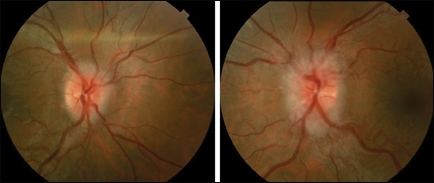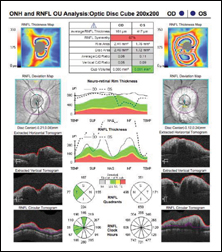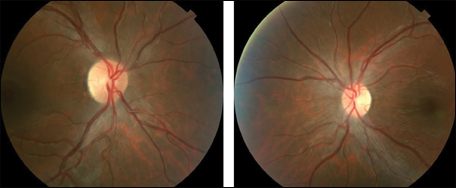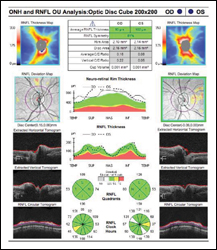Young woman referred for inferior visual field defect
The right eye had mild swelling of the superior, nasal and inferior disc margins, while the left eye had circumferential disc swelling with obscuration of the vessels.
A 23-year-old female preschool teacher was referred to the New England Eye Center by an outside ophthalmologist for evaluation of a new inferior visual field defect of the left eye. Over the preceding week, the patient noticed waxing and waning blurring of the inferior portion of the visual field in her left eye that became persistent upon waking 4 days before her presentation. She also reported a throbbing bifrontal headache and bilateral eye strain for 2 weeks.
Of note, the patient had recently increased her physical exercise with a new gym regimen. Her vision seemed to be blurrier during episodes of vigorous physical activity. There was no positional component to the headache, pulsatile tinnitus, dizziness, loss of consciousness or transient visual obscurations. She denied any recent gastrointestinal or respiratory infections, sexually transmitted infections, travel outside the region, insect bites or cat scratches. She denied any preceding flashes or floaters.
She had never seen an ophthalmologist but denied any issues with her eyes or history of ocular trauma. Her medical history included morbid obesity (390 lb) and an episode of minor head trauma approximately 1 year prior when she fell in the shower. She had no history of migraines or headaches, and did not take supplements or medications, including oral contraceptives, retinol or minocycline.
Examination
On examination, the patient was an otherwise healthy-appearing obese young woman. Her vision was 20/20-1 in the right eye and 20/30-1 in the left eye. Pupils had been pharmacologically dilated before arrival. IOP was 17 mm Hg in both eyes. External exam revealed normal lids and adnexa. Conjunctiva, sclera, corneas and anterior chambers were quiet. Irises were normal. Lenses were clear.
On dilated exam of the right eye, the retina was flat with normal course and caliber of retinal vessels. There was grade 1 disc edema of the right optic nerve head with mild swelling of the superior, nasal and inferior disc margins. In the left eye, there was circumferential (grade 4) disc swelling with obscuration of the vessels leaving the disc margin and subretinal fluid tracking from the optic disc to the macula. The cup-to-disc ratio was 0.1 in both eyes (Figure 1). Blood pressure was within normal limits.

Source: Adam Chin, MD
What is your diagnosis?
See answer on next page.
Bilateral disc elevation
Bilateral disc elevation can be the result of elevated intracranial pressure, inflammation or infiltration. Intracranial mass lesions, decreased cerebrospinal fluid (CSF) absorption and obstruction of venous drainage can lead to elevated intracranial pressure and must be ruled out with neuroimaging before subsequent lumbar puncture. In idiopathic intracranial hypertension, also known as pseudotumor cerebri, the intracranial pressure is found to be elevated; however, no mass lesion or other etiology of intracranial pressure elevation is discovered. Classically, these patients are overweight or obese women of childbearing age who present with visual field defects and headaches. In hypertensive optic neuropathy, systemic hypertension leads to vasospasm and ischemia resulting in disc swelling. Similarly, non-arteritic anterior ischemic optic neuropathy leads to disc edema due to compartment syndrome of the optic nerve head. As such, the condition is typically seen in patients with small or absent optic cups. Infiltration of the optic nerve by lymphoma, leukemia or carcinoma can also give the appearance of disc edema. Anterior optic neuritis caused by infections such as Lyme, cat scratch and syphilis and demyelinating diseases such as multiple sclerosis can lead to bilateral disc edema. Pseudopapilledema secondary to disc drusen or crowded optic discs is also on the differential.
Workup and management
Before the patient’s arrival at the New England Eye Center, Humphrey 24-2 visual field testing done by the outside ophthalmologist revealed an inferior altitudinal defect in the left eye. OCT of the retinal nerve fiber layer (RNFL) (Figure 2) confirmed bilateral disc edema showing an average RNFL of 161 µm in the right eye and 417 µm in the left eye. OCT of the macula revealed normal foveal contour in the right eye and subretinal fluid tracking from the optic nerve in the left eye.

Due to the patient’s body habitus, an MRI and lumbar puncture could not be performed immediately. Therefore, urgent CT of the head and orbits was obtained. Imaging revealed no intracranial masses but did show partially empty sella, mild brainstem sagging and minimal protrusion of the optic nerve heads. At this point, a diagnosis of idiopathic intracranial hypertension was suspected, and the patient was instructed to take 1 g of acetazolamide twice daily and to continue her exercise program while awaiting MRI and lumbar puncture.
Over the following 2 weeks, despite increasing the acetazolamide dose to 1 g three times daily, serial examinations revealed progressive disc edema bilaterally and subjective blurring of vision on the right in addition to the left. Lumbar puncture revealed opening pressure of 18 cm H2O. CSF analysis was limited due to bloody tap. Open MRI of the head and orbits demonstrated bilateral optic nerve enhancement. There was no evidence of white matter involvement to suggest MS. ACE of 56 U/L and lysozyme of 5.2 µg/mL were within the normal range. Neuromyelitis optica IgG was negative. Lyme titers showed positive IgM and negative IgG. Confirmatory Western blot testing for Lyme was positive, with two of three IgM bands positive. Our patient was diagnosed with bilateral papillitis due to neuroborreliosis.
Discussion
In the northeast region of the United States and northern Europe, Lyme disease is a common tick-borne infection that results from the transmission of Borrelia spp. from the Ixodes spp. tick to a human host. Within days to weeks of inoculation, local infection can lead to an erythema chronicum migrans rash characterized by centrifugal erythematous rash with a target-like appearance. Ocular findings in this first stage of infection include conjunctivitis. As the organism disseminates hematogenously in the second stage of infection, constitutional symptoms, fever and lymphadenopathy are present. In stage 2, there is spread of the organism through the blood and lymphatic system. Ocular findings during this stage may include disc edema, keratitis, granulomatous inflammation, uveitis and orbital myositis. Neuro-ophthalmic manifestations include facial nerve palsy, optic neuritis and meningitis. In persistent infection (stage 3), varied neurologic manifestations and arthritis are seen.
Neuroborreliosis refers to central nervous system involvement as in optic neuritis. In studies reviewing cases of optic neuritis associated with neuroborreliosis, the most common systemic symptoms include headache, arthralgias and myalgias. In the literature, the most strict diagnostic criteria for Lyme neuroborreliosis requires exposure to endemic area, negative syphilis testing, no evidence of MS, positive serum Lyme testing, positive confirmatory Western blot as well as positive CSF studies. However, only a handful of reported cases have met this strict diagnostic criteria.


The treatment of Lyme disease depends on the presentation. While early local disease characterized by erythema migrans can be treated with a 10-day course of doxycycline, Lyme disease affecting the cranial nerves and nerve roots should be treated with a 14-day course of oral doxycycline. As in our case, neuroborreliosis requires a 14-day course of intravenous ceftriaxone.
Our patient was treated with a 14-day course of IV ceftriaxone after receiving 3 days of IV solumedrol before the diagnosis of neuroborreliosis. At 2-month follow up, her vision was 20/20-1 in both eyes with complete resolution of disc edema on exam (Figure 3). OCT of the optic nerve showed a decrease in thickness of the RNFL (Figure 4). Visual field tests were essentially full bilaterally.
- References:
- Balcer LJ, et al. J Neuroophthalmol. 1997;17(2):108-121.
- Fedorowski JJ, et al. Clin Infect Dis. 1996;doi:10.1093/clinids/23.3.639.
- Kan L, et al. Pediatr Neurol. 1998;doi:10.1016/S0887-8994(97)00215-4.
- McVeigh K, et al. Clin Ophthalmol. 2012;doi:10.2147/OPTH.S32601.
- Rothermel H, et al. Pediatrics. 2001;108(2):477-481.
- Träisk F, et al. Curr Opin Ophthalmol. 2012;doi:10.1097/ICU.0b013e328358b1eb.
- For more information:
- Adam Chin, MD, and Laurel N. Vuong, MD, can be reached at New England Eye Center, Tufts University School of Medicine, 750 Washington St., Box 450, Boston, MA 02111; website: www.neec.com.
- Edited by Aubrey R. Tirpack, MD, and Astrid C. Werner, MD. They can be reached at the New England Eye Center, Tufts University School of Medicine, 750 Washington St., Box 450, Boston, MA 02111; website: www.neec.com.









